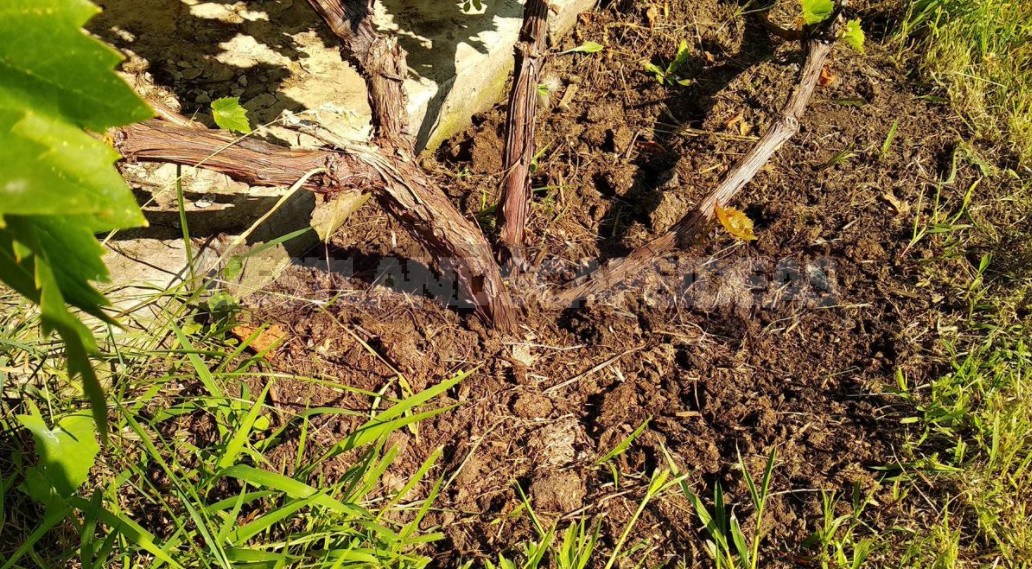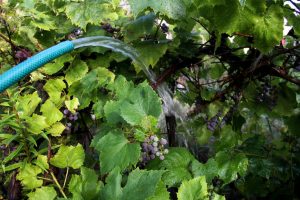We can not say that grapes are an authentic plant for the entire territory of its cultivation. Therefore, the methods of watering this peculiar crop must be thought out, otherwise you will not be able to get a rich and high-quality crop. Our reader subtly noticed the main mistakes of horticulturists and shared smart ways to organize this process.
Mistakes
“Watering the air” is a favorite occupation of many summer residents. There are usually two ways to do this. First, carefully pour water near the stem of an adult Bush or under the trunk of a tree. This is a psychological phenomenon. For some reason, the place where the trunk sticks out is perceived as something important. Most likely, this is a fixed reflex of happy care for young seedlings. The joy of this occupation was added by the fact that it was enough to pour 1 bucket into 1 specific place. It is well known that the ability to reduce work to a minimum is the main incentive for any activity! So we pour under the Bush while the feeding roots have long lived in the aisles…

Another way to appease your “caring instinct” is to pour water on the surface of bare soil. Apparently, the wet earth is associated with childhood memories of fun running through puddles. There is no other explanation. After all, in order for this water to reach the roots, you need to pour at least 6-7 buckets per square meter. Moreover, high humidity in the vineyard increases the development of fungal diseases. But the feeling of caring for plants is not related to the result — it is valuable in itself!
Smart watering
Consider options for watering grapes, aimed at the result. But first, let’s learn what smart watering is:
- it supplies water directly to the root zone;
- does not allow it to be lost through evaporation;
- along with water, if necessary, it also supplies useful substances (if combined with top-dressing).
1. Pits
This method is used by smart summer residents in different regions. It is very effective for any perennial crops (especially for “feeding” seedlings), very easy to install and cheap. Along the perimeter of the crown, that is, in the zone of feeding roots, after 1.5-2 m dig holes with a width of a bayonet and a depth of two bayonets with a shovel. For an adult Bush, 5-6 pits are enough.
Fill them with stones or large gravel, and cover them with lids from garbage (you can insert holes in them plastic containers). That’s where they pour the water. The more you pour, the greater the volume of soil around will be moistened. Usually you need 2-3 buckets for the hole, this is enough for 1 month.
Experienced gardeners use pits as a technique that guarantees the powerful development of seedlings of any crops. Directly in them, you can lay droppings, manure or other organic matter and combine watering with fertilizing. If the vineyard periodically suffers from chlorosis, every third pit put a nutrient mixture: 100 g of superphosphate and 100 g of iron vitriol with humus. Enough of this prevention for three years.
After 2-3 years, the pits are filled with earth. Then new ones are arranged between them — and new roots come to live here for their own pleasure. Pits dug monthly are a great way to track soil moisture. I dug it up half a meter — estimate the humidity and the need for watering. Then fill it with rocks or organic matter.
The next two ways of smart watering are the development of the same idea.
2. Trenches
It is used by masters from different zones. In the aisle, at a distance of 1-1. 5 m from the bushes, dig a narrow trench 2-3 bayonets deep. In fact, it is a continuous long pit that can feed more roots. On the bottom, you can put a small layer of manure (or other organic matter, if available). Up to half of the trench is covered with large gravel or stones. Every 4-5 m into the stones stick pipes or boxes for irrigation.
Stones are covered with slate, boards, roofing material or film. The trench is filled with earth. Over such a source of moisture, it is convenient to arrange a stationary bed for strawberries or other plants. The subtlety here is one: after digging a trench, you need to let water run through it and level the bottom, so that the water does not flow immediately in one direction and does not accumulate in the depressions. Watering is simple: a hose is lowered into the next pipe and the approximate time for which the desired hundredweight of water should pour out is marked. You can also add all sorts of fertilizers to the pipes.
3. Baths
A shallow “bath” is dug in the aisle. From the removed earth form the sides. Watering is simple: the bath is filled with water, and when the moisture is absorbed, cover with straw, grass, cardboard or roofing material. Here you can add manure or manure and layer it all with weeds, leaves, sawdust, straw and other debris. Very useful here will be ash, and if it is not-potassium-phosphorus fertilizers.
Each bath can be a small compost heap. The soil under this mulch quickly becomes permeable, and with each watering, the roots receive a nutritious infusion. In the same tub, on mulch, cucumbers, zucchini, pumpkins or other plants that are friendly to grapes will grow perfectly.
This method of irrigation-nutrition-soil improvement is very natural, simple and effective. In fact, the bath is an organic garden with a more pronounced watering function. Perhaps, for all bushes such “Jacuzzi” can not be made, but for the most needy — it is quite real.







